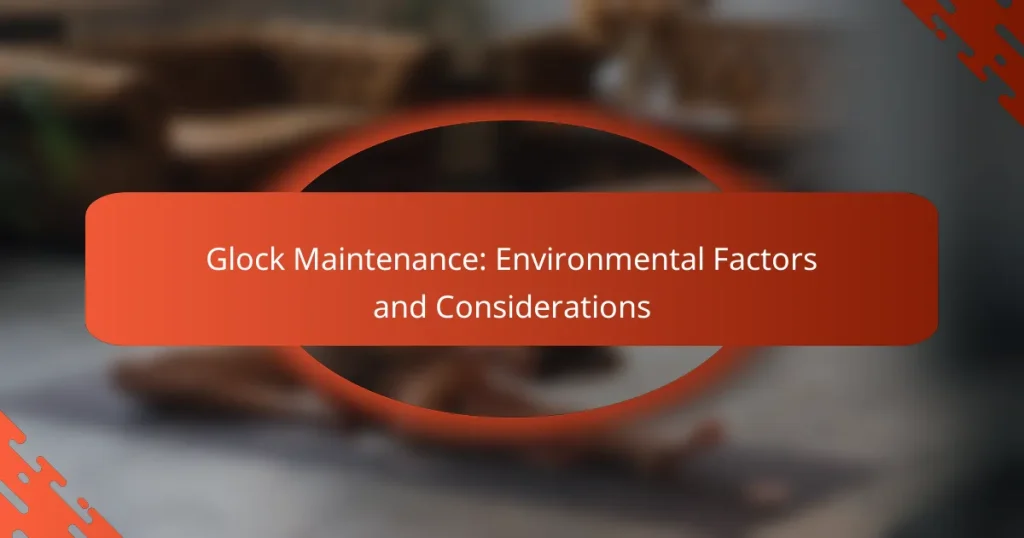Proper maintenance of a Glock is crucial for ensuring its reliability and longevity, particularly in relation to environmental factors. Humidity, temperature, and exposure to dust can all significantly affect the firearm’s performance, leading to issues such as corrosion and component wear. By maintaining optimal storage conditions and conducting regular maintenance, gun owners can protect their Glocks from these environmental challenges.

How does humidity affect Glock maintenance?
Humidity significantly impacts Glock maintenance by increasing the risk of corrosion and affecting lubrication and ammunition reliability. Maintaining a proper environment can help mitigate these issues and ensure optimal firearm performance.
Increased corrosion risk
High humidity levels can lead to increased corrosion on metal parts of a Glock, including the slide and barrel. Moisture in the air can condense on surfaces, promoting rust formation if not properly managed.
To combat corrosion, regularly clean and oil your Glock, especially after exposure to humid conditions. Using a rust-inhibiting oil can provide an extra layer of protection against moisture.
Impact on lubrication effectiveness
Humidity can dilute or wash away lubricants used on your Glock, reducing their effectiveness. When lubricants break down, friction increases, which can lead to wear and malfunction during operation.
Consider using heavier lubricants that are less prone to evaporation in humid conditions. Regularly inspect and reapply lubrication to ensure smooth operation, particularly after extended use in humid environments.
Effects on ammunition reliability
High humidity can affect the reliability of ammunition by causing moisture to penetrate cartridges, which may lead to misfires or reduced performance. This is particularly true for ammunition stored in non-sealed containers.
Store ammunition in a cool, dry place and consider using desiccants in storage containers to absorb moisture. Regularly check your ammo for signs of corrosion or damage, especially if exposed to humid conditions for extended periods.

What temperature conditions are ideal for Glock storage?
The ideal temperature conditions for Glock storage range from approximately 15°C to 25°C (59°F to 77°F). Maintaining this range helps ensure the firearm’s components remain in optimal condition and function reliably when needed.
Optimal range for performance
For peak performance, Glocks should be stored in a stable environment where temperatures do not fluctuate significantly. Consistent temperatures within the ideal range help prevent issues such as lubrication breakdown and material degradation. Keeping the firearm in a climate-controlled space is advisable for long-term storage.
Effects of extreme temperatures
Extreme heat can cause lubricants to evaporate or break down, leading to increased friction and potential malfunctions. Conversely, extreme cold can cause materials to contract, which may affect the firearm’s operation and reliability. It is essential to avoid exposing your Glock to temperatures outside the recommended range to ensure its longevity and performance.

How does exposure to dust and debris impact Glock functionality?
Exposure to dust and debris can significantly hinder Glock functionality by obstructing moving parts and accelerating wear on components. Regular maintenance is essential to ensure reliable operation and longevity of the firearm.
Clogging of mechanisms
Dust and debris can accumulate in the internal mechanisms of a Glock, leading to clogs that may prevent proper cycling of the action. This can result in malfunctions such as failure to feed or eject cartridges, which can be critical during use.
To mitigate this risk, it is advisable to perform routine cleaning, especially after exposure to dusty environments. Using a soft brush and compressed air can help remove particles from hard-to-reach areas.
Increased wear on components
Continuous exposure to dirt and debris can cause increased wear on various components of a Glock, such as the slide, barrel, and recoil spring. This wear can lead to decreased accuracy and reliability over time.
To minimize wear, consider using protective covers or cases when transporting the firearm in dusty conditions. Regular lubrication with appropriate gun oil can also help reduce friction and prolong the life of moving parts.

What are the best cleaning practices for Glocks in various environments?
The best cleaning practices for Glocks depend on the environment in which they are used. Regular maintenance is crucial, especially in harsh conditions, to ensure reliability and longevity.
Regular cleaning schedules
Establishing a regular cleaning schedule is essential for Glock maintenance. For firearms used in dry, clean environments, a monthly cleaning may suffice, while those exposed to moisture, dust, or heavy use should be cleaned after each use or weekly. This helps prevent corrosion and buildup of debris.
Consider seasonal factors as well. For example, if you frequently use your Glock during hunting season, increase the frequency of cleaning during that time to account for exposure to the elements.
Recommended cleaning products
Using the right cleaning products is vital for maintaining your Glock. A high-quality gun cleaner, lubricant, and a bore brush are essential. Look for products specifically designed for polymer frames and metal parts to avoid damage.
Popular choices include CLP (cleaner, lubricant, and protectant) solutions and dedicated gun oils. Always check the manufacturer’s recommendations for compatible products to ensure optimal performance and protection.

How can environmental factors influence Glock reliability?
Environmental factors such as moisture and temperature can significantly impact the reliability of a Glock. Understanding these influences helps ensure optimal performance and reduces the risk of malfunctions in various conditions.
Effects of moisture on firing
Moisture can lead to corrosion and rust on critical components of a Glock, affecting its firing reliability. When exposed to high humidity or rain, the internal mechanisms may become compromised, leading to potential misfires or failures to eject.
To mitigate moisture-related issues, regularly inspect and clean your Glock, especially after exposure to wet conditions. Using a quality gun oil can help protect metal surfaces from moisture damage.
Temperature-related malfunctions
Extreme temperatures can adversely affect Glock performance. In cold environments, lubricants may thicken, causing sluggish operation, while high heat can lead to increased wear and potential failures in the polymer frame.
When operating in extreme temperatures, consider using temperature-appropriate lubricants and ensure your Glock is stored in a climate-controlled environment when possible. Regular maintenance checks can help identify any temperature-related wear before it leads to malfunction.

What accessories can enhance Glock maintenance in adverse conditions?
Several accessories can significantly improve Glock maintenance in challenging environments, ensuring reliability and performance. Key items include protective cases and weather-resistant lubricants, which help shield the firearm from moisture, dirt, and temperature fluctuations.
Protective cases
Using protective cases is essential for maintaining a Glock in adverse conditions. These cases provide a barrier against moisture, dust, and impact, which can compromise the firearm’s integrity. Look for cases made from durable materials like hard plastic or reinforced fabric, and ensure they are water-resistant or waterproof.
When selecting a protective case, consider features such as airtight seals and customizable foam inserts for secure storage. A good case not only protects the Glock but also makes transportation safer and more convenient, especially in outdoor or rugged settings.
Weather-resistant lubricants
Weather-resistant lubricants are crucial for Glock maintenance, particularly in extreme temperatures or humid environments. These lubricants are formulated to withstand moisture and temperature changes, preventing rust and ensuring smooth operation of moving parts. Look for products specifically labeled as weather-resistant or all-weather lubricants.
When applying lubricants, use them sparingly to avoid attracting dirt and debris. Regularly check and reapply as needed, especially after exposure to harsh conditions. A well-lubricated Glock will function reliably, reducing the risk of malfunctions during critical moments.

What are the signs of neglect in Glock maintenance?
Signs of neglect in Glock maintenance can manifest as decreased performance, including accuracy issues and parts that fail to operate correctly. Regular inspection and care are essential to ensure reliability and safety during use.
Decreased accuracy
Decreased accuracy in a Glock can indicate a lack of proper maintenance. Factors such as dirty barrels, worn-out sights, or improper lubrication can lead to inconsistent shot placement.
To maintain accuracy, regularly clean the barrel and check the sights for alignment. If you notice a significant drop in precision, consider having a professional inspect the firearm.
Malfunctioning parts
Malfunctioning parts are a clear sign of neglect in Glock maintenance. Common issues include failure to eject, failure to feed, and light strikes, which can stem from dirty components or worn springs.
To prevent these malfunctions, perform routine cleaning and replace springs as recommended, typically every few thousand rounds. Keep an eye out for any unusual wear or damage that could compromise functionality.

How does geographic location affect Glock maintenance strategies?
Geographic location significantly influences Glock maintenance strategies due to varying environmental conditions. Factors such as humidity, temperature, and exposure to elements can affect the performance and longevity of the firearm.
Coastal vs. inland considerations
Coastal environments often present higher humidity and salt exposure, which can lead to corrosion and rust on metal parts of a Glock. Regular cleaning and application of protective lubricants are essential in these areas to mitigate the effects of moisture and salt.
In contrast, inland areas may experience drier conditions, which can lead to dust accumulation and potential wear on moving parts. While corrosion may be less of a concern, regular maintenance should still focus on cleaning and lubrication to ensure optimal function.
When maintaining a Glock in coastal regions, consider using stainless steel components or specialized coatings that resist corrosion. For inland locations, a routine cleaning schedule after exposure to dust or dirt can help maintain the firearm’s reliability.

